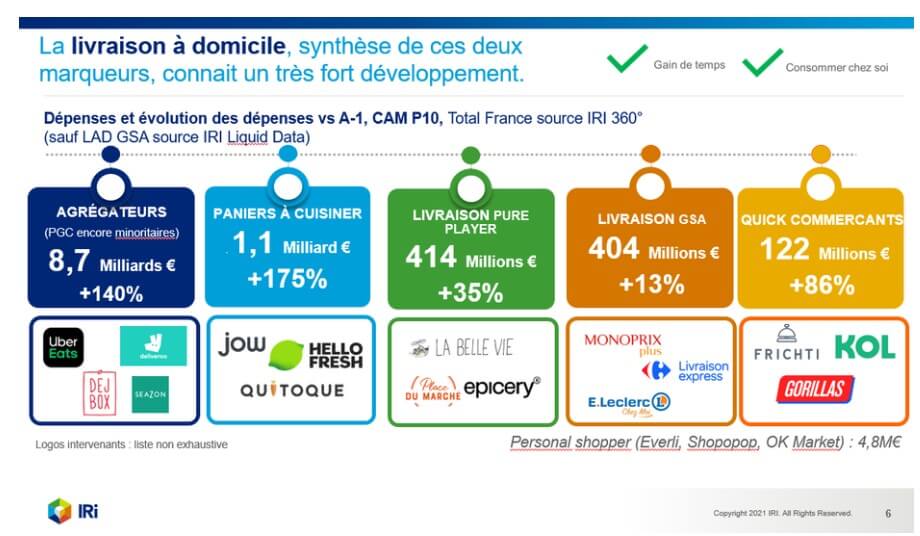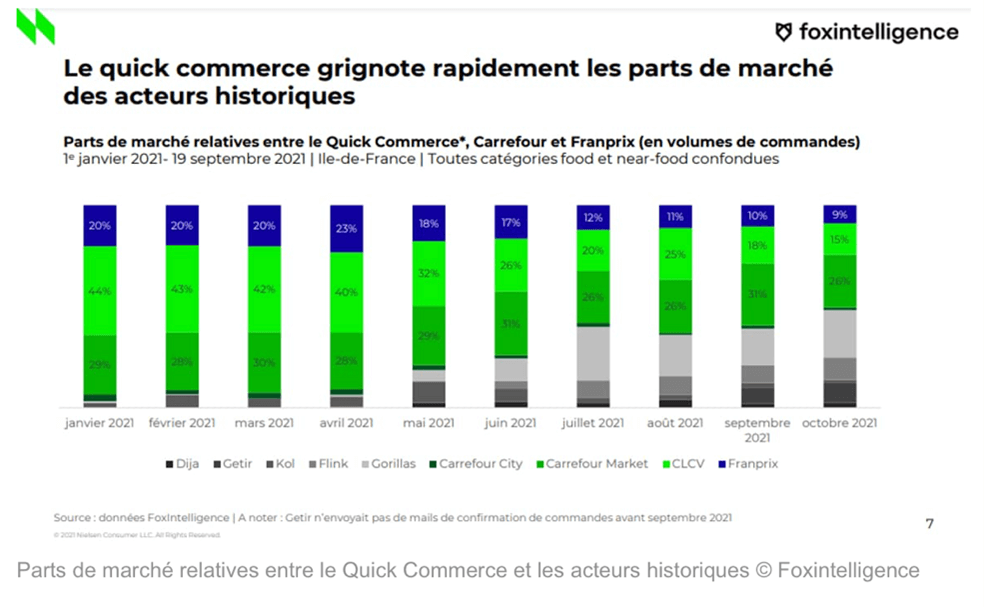For the past year, we've been hearing about Quick Commerce, and our metro platforms have been invaded by posters featuring new companies offering ever-faster delivery services.
What is Quick Commerce?
Quick Commerce refers to commercial distribution activities based on the promise of delivery within a very short timeframe (10 to 15 minutes).
Quick Commerce activities serve densely populated urban areas, and generally rely on small warehouses or hubs located in city centers and referred to as "dark stores".
Theassortment on offer is generally smaller than that of a local convenience store (between 1,500 and 2,000 items).
Against the backdrop of the pandemic of the last two years, online food retailing has grown strongly.
The market has grown by 50% in two years, from €6 billion in 2019 to €9 billion in 2021.
In the food delivery market, quick merchants still have some way to go compared with the home delivery behemoths. To date, their penetration rate of French households is 1.5%, and the vast majority of these are Parisian or urban households (in Paris, the penetration rate is 7 times higher than in the rest of France).
In France today, there are 8 players in this market who didn't exist just a year ago.
The key to expansion is therefore to conquer new territories, while retaining the two strong "LAD" trademarks:
- Saving time
- Enjoy it at home
What is the Quick Commerce business model?
The basic concept is that it's quicker and more convenient to order the missing parmesan cheese for your cooking pasta than to buy it at the corner store. By the time your pasta is ready, the cheese will be delivered.
To achieve this, we need to move fast.
Orders are prepared in a "dark store" in record time (between 2 and 3 minutes). This is generally an old store that is not open to the public, but which contains all the shelves of staple products that may require repair.
These small warehouses are between 200 and 400m2 in size and contain between 1,500 and 2,000 SKUs.
Once the order has been prepared, it is delivered by electric bike within a radius of 1.5 to 2km.
Delivery charges apply for most players, as does a minimum order value.
Product prices are those of a local mini-market, and even cheaper than a Franprix; all the more so as quick merchants can use very aggressive promotions.
What does the future hold for Quick Commerce?
IRIthe American Big Data pioneer identifies a "boulevard" for home delivery in hyper-urban areas, where drives are unable to develop.
But can Quick Commerce survive and grow beyond convenience shopping, while maintaining its promise of speed?
For the business model to work, several conditions must be met:
- Increase the number of deliveries per hour (minimum 4 vs. 3 today)
- Modulate delivery rates by day/time
- Increase average basket (from €25 to €30)
- Improve product mix by adding higher-value references
- Restricting the catchment area
- Obtain attractive purchasing conditions (following the example of Cajoo, in which Carrefour has invested).
- Reaching over 500 orders per day
We're seeing a lot of people being called up, but very few elected.
These will be the ones who can :
- Massive and sustainable cash injection
- Keeping the promise of speed
- Guarantee the quality of products delivered
- Increase assortment while maintaining productivity
The question is: is there enough demand to satisfy all these requirements?
By Claire Jagodzinski
------
Sources :
- LSA Commerce Connecté - Quick commerce: a market worth 122 million euros in France
- Marketing definitions - Quick Commerce
- Les Echos / Tribune - Quick commerce: a booming market
- Le Web Grande Conso - Focus Grande Conso: 5 questions about quick-commerce


